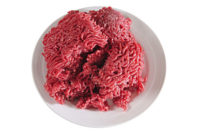Recalls for pathogens in raw products

By definition, a pathogen can cause illness. However, for the pathogen to be an adulterant under the Inspection Acts, where the presence of the organism will trigger regulatory action, FSIS must demonstrate either: (1) under ordinary conditions of use, the pathogen could cause illnesses; or, (2) in a specific situation, the presence of the pathogen in the production of one particular product has directly caused illnesses.
The first class of adulterants, those causing illness under ordinary conditions of use, is much more familiar. There is no dispute that the presence of pathogens, such as Salmonella, E. coli O157:H7 and Listeria monocytogenes, in a ready-to-eat product can cause illness because the product will not receive an additional lethality treatment under ordinary conditions of use.
Although not universally accepted at first, FSIS declared E. coli O157:H7 an adulterant in raw, non-intact beef in 1994. FSIS then had to defend its determination in a Federal District Court. It successfully defended its decision by proving to the court that under the ordinary conditions of use, many consumers undercooked ground beef and, as a result, there had been illnesses caused by this pathogen. Texas Food Industry Association v. Espy, (W.D. Tex., December 13, 1994).
The second class of adulterants, those causing illness in discrete cases, is quite different. In these cases, there is no per se rule that if the pathogen is on the product, the product is adulterated; rather the determination is based on the facts surrounding each case. Put another way, these adulterants are adulterants only in hindsight — the product is adulterated because the product actually caused illness; whereas, the first class of adulterants is more prospective — product is adulterated because the pathogen could cause illness under ordinary conditions of use, not that any illnesses actually resulted.
From the legal perspective, the second class of adulterants is not based on ordinary conditions of use; instead, the decision is based on the evidence, (i.e., illnesses) that the product from a specific production is “unsound, unhealthful, unwholesome, or otherwise unfit for food.”
Given the second class of adulterants depends on the facts, establishments should know which facts must be present to support the agency’s decision in a particular case. All must be present for the stars to align:
l There must be actual illnesses which are linked through molecular DNA typing, primarily PFGE, but may include MLVA, e.g., a cluster of case-patients;
l There must be an epidemiological link between the case-patients and a specific production of product (e.g., a known lot or lots); and
l The specific production lot/day must account for at least some of the illnesses (how many depends on the strength of the epidemiological and microbial DNA evidence).
Without the link of specific product to specific illnesses, FSIS has not requested a recall or taken any further action because there is no specific product that has been associated with illnesses to recall. FSIS has issued a public health alert when there is known illnesses and known product type (e.g., salmonellosis associated with raw, stuffed chicken breast but the specific lot could not be isolated).
However, a variety of changes has made it easier for FSIS to link a specific product to a cluster of illnesses. State investigations are generating more molecular patterns for CDC. With this, CDC has more information to identify possible related illnesses. Once a cluster is discovered, the case patients’ retail shopper cards provide evidence as to common purchases.
With shopper information, especially if coupled with microbial DNA generated by FSIS in its regulatory sampling and other government sampling, FSIS can identify “establishments of interest.” At that point, all that remains is whether an establishment’s distribution data puts a particular product on the store shelves at the different locations where the case-patients could have bought (and actually did buy) the product.
It is hard to be proactive in these situations. That said, an establishment should work to reduce any pathogens from its products. A pathogen in the raw product may not be an adulterant now, but it could be later if that product causes illnesses.
Looking for a reprint of this article?
From high-res PDFs to custom plaques, order your copy today!







